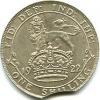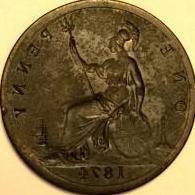|
|
The current range of books. Click the image above to see them on Amazon (printed and Kindle format). More info on coinpublications.com |
|
|
-
Content Count
662 -
Joined
-
Last visited
Community Reputation
3 NeutralAbout Geoff T
-
Rank
---

- Birthday 07/07/1955
Contact Methods
-
Website URL
http://
Profile Information
-
Gender
Male
-
Location
Stockport/Manchester UK
-
Interests
Half crowns, copper farthings, commemorative medals. Classical music, architecture, languages, travel, cooking, wine...
-

2011 Edinburgh Pound Coin
Geoff T replied to alloy's topic in British Coin Related Discussions & Enquiries
I just checked the Royal Mint website, which lists 2011 mintage figures for £2, 50p and 20p, but none for the £1. It may be that it was a late mintage, and therefore they have suddenly started flowing onto eBay? The Belfast 2010 coins took a while to enter circulation, then seemed to be everywhere. I managed to get four in my change at once, but it was late 2011 or early 2012, and prior to that I'd only seen them in proof. G -

1837 halfcrown
Geoff T replied to william iv's topic in British Coin Related Discussions & Enquiries
I think you deserve a serious reply on this one, especially as I see you're a starter member. Am I right in saying you're looking to buy one, rather than asking for the going rate for one you already have? In the latter case a photo would be useful. If the former, then everything is going to depend on the condition. You can pick up a decent one in Fine for under £100, but with coins like this the hike in price as the grading gets higher can be quite a huge leap. The 1837 half crown is regarded as rare because its official mintage figure was only around 150,000. That's less than the 1905 (160,008). However, given that lower grade 1837s are quite easy to come by, I suspect that a substantial number might well have been struck in 1838 using 1837 dies - particuarly given the change of reign/design/dies - but not included in the mintage figures for 1837. Conversely, I suspect that the rarity of the 1835 is because the mintage figures for that year include many struck from 1834 dies - and 1834 is very common. Geoff -

How much literature do members have and use?
Geoff T replied to Rob's topic in British Coin Related Discussions & Enquiries
You mean he uses hs where he should be using ns. You mean you don't understand simple Englisn, Rob? Englisn is a recorded variety, known to have been occasioned by a tired typesetter at the end of a hard day -

How much literature do members have and use?
Geoff T replied to Rob's topic in British Coin Related Discussions & Enquiries
ESC is a good start, but Davies is more detailed for the post-1816 stuff, although his written Englisn is at times a little strange. G -
My Latin teacher, who doubled as a certified sadist, had a novel way of reminding those who forgot the difference between the active and the passive voice. He'd borrow a gym shoe from the lad with the largest feet in the class and ask the forgetful one to bend over. "Mr M***** slippers X - active", followed by a whack. Another whack and "X is slippered by Mr M***** - passive". That was one of his milder tortures. The amazing thing is that we all took it as read that teachers were allowed to do things like that. It sounds like Dotheboys Hall in the 19th century, but it was actually a grammar school in the 1960s. O tempora, o mores! But I thought it was an irregular verb like fero, ferre, tuli, latum? Damifino, Ihaven'taclue, Don'taskme, Whydon'tyouGoogle
-
For reasons lost to the mists of time, we used to eat Polo mints in 5th form maths lessons. A packet of Polos cost 4d, which as of today was redefined as 1.5p. I realised that three packets, which formerly cost a shilling, would now cost 4.5p - a saving of a whole new halfpenny. So reader, I bought them. Thus on 15 February 1971, with a clear eye for a bargain, I made my first fully decimal purchase and saw those funny new bronze coins at first hand. Life-changing, when you come to think of it. Can anyone else d'un certain age remember their experiences of D-Day? Geoff
-

Quuen Anne - fake? help wanted please
Geoff T replied to newkidonbloc's topic in British Coin Related Discussions & Enquiries
This isn't Anne, for a start - it's Elizabeth I! -

What could you buy with 1/3 Farthing in 1880's?
Geoff T replied to palves's topic in British Coin Related Discussions & Enquiries
Hi Palves - Try this site http://www.measuringworth.com/ppoweruk/ Geoff -

1887 Half Crown
Geoff T replied to King Norton's topic in British Coin Related Discussions & Enquiries
Hi, I'm assuming that you mean the Jubilee Head 1887; if you have a Young Head proof you're luckier than most of us. Some of the early strikings of the JH 1887 coins look like proofs as they have a mirror-like surface, but they don't have the other hallmarks of the genuine proofs such as the the sharper milling. I have the 1887 JH proof as well as a proof-like early striking of the 1887 JH florin, and when you put them together the difference is obvious. 1887 JH is extremely common, but if you have one of the early strikings it's still a very nice coin. Geoff -

commemorative coin-medallion
Geoff T replied to a topic in British Coin Related Discussions & Enquiries
I don't think you need Google - if you read the legend on the reverse, it gives you all the historical information you could want, including the precise date. There are a few dedicated commemorative medallion collectors, but it's a small field compared to coins. The obverse is very common. It's used in a large number of the regional 1902 Edward VII coronation medals. -

1905 royal visit to harrow commemorative coin
Geoff T replied to a topic in British Coin Related Discussions & Enquiries
Heres the pictures guys hope they help Yes, it is a medallion. These things were extremely common and it's probably not worth more than a fiver. -

Help... Farthing 1821 "G" over "O" variety or not?
Geoff T replied to Voynov_BG's topic in British Coin Related Discussions & Enquiries
My guess is that the die suffered wear (or broke) on the "I" in GRATIA, and was repunched. The T may also have been repunched. Difficult to say about the G - it's possibly G over G? The G in GEORGIUS is an interesting distance from the other letters. The first "G" in "Georgius" is normally spaced like that on George IV farthings. The overstrike is interesting but not unexpected given the plethora of them in the George IV series. I've come across quite a few which aren't recorded. -

Victoria 18? coin possibly a penny
Geoff T replied to thedigger's topic in British Coin Related Discussions & Enquiries
Hello peckris, Ive taken another photo as requested and hope that from this you will be able to determine the date if possible mate.? cheers How about looking at the reverse. If there's only one stop after FID then there's a good chance it's an 1838; two stops and it must be 1858. I've seen numerous 58s being sold as as 38s and vice versa. G -

Books on Farthings
Geoff T replied to Kronos's topic in British Coin Related Discussions & Enquiries
Other than books covering the copper and bronze coinage (Peck, Bramah, Freeman etc), there are no specific farthing books that I am aware of. It is a project I am looking into at the moment. The Colin Cooke catalogues are the only other literature that used to have features on varieties etc. The Colin Cooke collection sale catalogue of May 2006 itself provides a fairly detailed listing with many varieties (well illustrated in colour) from the earliest types through 1956. It also includes fractionals. Since this collection was probably the most complete ever assembled this constitutes good coverage of the series, although I noted a few items missed the sale such as the 1953 varieties, Colin's 1860 and 1864 copper farthings, etc. (I assume either held back from the sale or sold privately). You might check with the Colin Cooke website to see if the catalogue might still be available. Also, the website itself has a section on collections which documents this sale and the Oxford Collection sale. I have a spare copy of the Cooke sale catalogue if you're interested in making me an offer. At one stage I ended up with four. It's still a very good record. I'm not sure what happened to the 1860 and '64 copper, but they were certainly not in the sale. I hope they're now in good hands. G -

The 1869 penny
Geoff T replied to 1949threepence's topic in British Coin Related Discussions & Enquiries
There's something similar with 1835/36/37 half crowns. The 1835 is very hard to find yet the mintage figures are by no means low, but I suspect that they include a large number struck in 1835 but dated 1834. The very low mintage figures for 1837 (less than 1905) aren't borne out by the fact that you see a fair number of them, at least in lower grades. Again, I suspect that many more were struck in 1838 from 1837 William IV dies to make up a shortage while new designs for Victoria were still on the drawing board. Geoff
 Coinpublications.com
Coinpublications.com





.jpg.0f16482f8c8a5cc46088b8f22ec5a3be.thumb.jpg.343b0843d2024d4b6d30083a26d74c39.jpg)
